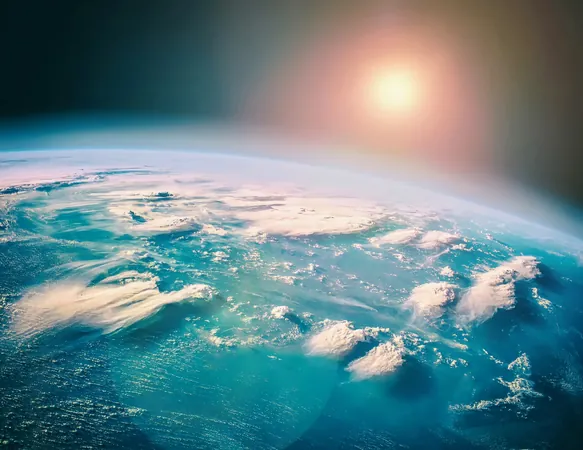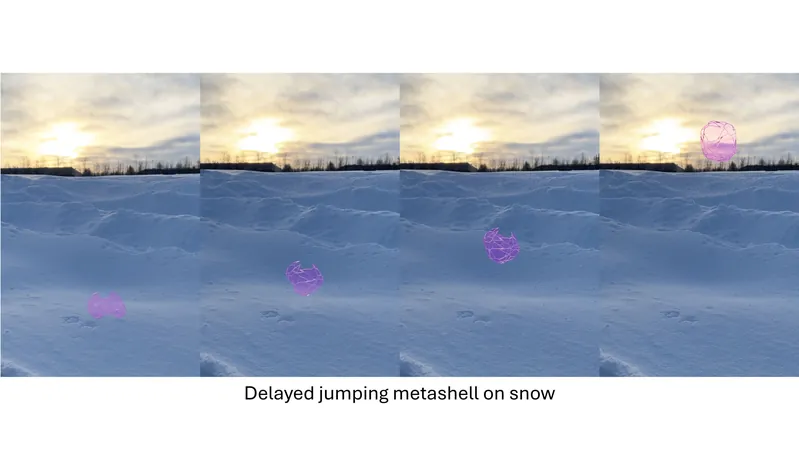
Earth’s Ozone Layer: A Two Billion Year Journey to Protection
2025-01-08
Author: Arjun
Earth’s Ozone Layer: A Two Billion Year Journey to Protection
When we enjoy Earth's natural wonders—the sweet scent of blooming roses, the symphony of songbirds, or the vibrant palette of autumn leaves—there's an unseen guardian at work: the ozone layer. This fragile barrier in the stratosphere serves as a protective shield, safeguarding our planet from harmful ultraviolet radiation (UVR) and playing a fundamental role in supporting life as we know it.
However, a recent groundbreaking study reveals that the establishment of this crucial layer took over two billion years, largely due to a complex battle between atmospheric elements that has only recently come to light.
The Ancient Battle: Iodine vs. Oxygen
Researchers from Yale University have uncovered new insights into why the ozone layer's stabilization was significantly delayed. Their study posits that a fierce competition existed between iodine and oxygen in the early Earth’s atmosphere, which prolonged the formation of a stable ozone layer and, as a result, hindered the rise of complex life.
Lead author Jingjun Liu remarked, “The origin and diversification of complex life on Earth remains one of the most profound and enduring questions in natural science.” This research challenges previously accepted notions that attributed the slow pace of evolution solely to biological factors.
Complex Life's Long Wait Explained
Cyanobacteria have existed for approximately 2.7 billion years, yet complex land plants only appeared about 450 million years ago. Fossils of more advanced life forms only emerge prominently in the fossil record during the Cambrian era. Historically, these extensive delays have been chalked up to evolutionary processes taking time, but new findings suggest otherwise.
Professor Noah Planavsky, the study's senior author, highlights a significant point: “That notion fails to explain how and why complex life originated and diversified.” The freshly unveiled evidence indicates that high concentrations of marine iodine interfered with ozone stabilization, allowing intense UV radiation to bathe the Earth’s surface. This hostile environment proved untenable for the development of intricate terrestrial life for billions of years.
The Consequences of Marine Iodine on Ozone Levels
The formation of ozone relies on a delicate interplay between oxygen and UV rays. While oxygen concentrations eventually increased, the study reveals that high levels of marine iodide emissions—salts produced by iodine—actively undermined the formation of a stable ozone layer. The ozone depletion effects were reminiscent of the damage caused by chlorofluorocarbons (CFCs) during the notorious Antarctic ozone hole crisis of the 20th century.
Professor Planavsky elaborated that “iodine-driven catalytic cycles for ozone destruction are kinetically much faster” than those involving reactive chlorine, meaning even modest increases in marine iodine could result in drastic ozone depletion.
A Transformational View of Earth's History
Utilizing geological evidence and sophisticated ocean-atmosphere models, the Yale research team reconstructed the historical dynamics between iodine and ozone. The findings suggest that low and unstable ozone levels persisted from around 2.4 billion to 0.5 billion years ago. Even with increased oxygen production, sporadic surges of UV radiation would have impeded the evolution of land-based life.
This transformative research not only reshapes our understanding of Earth’s formative history but also underscores the vital connections between atmospheric chemistry and the evolution of life on our planet. As we peel back the layers of Earth’s past, we continue to deepen our appreciation for the intricate balance that maintains life today.
Protecting the Ozone Layer's Legacy
The genesis of the ozone layer was a protracted, multifaceted journey shaped by elemental rivalries. This natural protector is not merely a scientific marvel; it represents the intricate interplay between Earth’s systems and the life they support. Without it, the delicate ecosystem—including flora, fauna, and the little joys that adorn our daily lives—would struggle to thrive.
Today, the ozone layer confronts new challenges from human activities, including pollution and the emission of ozone-depleting substances. The imperative to safeguard this layer is about more than preserving Earth’s aesthetic beauty; it’s critical for protecting the very foundation of our ability to coexist on this planet.
As research continues to unveil the complexities of our planet's history, the importance of understanding and mitigating human impacts on the ozone layer becomes more urgent than ever. The study is featured in the Proceedings of the National Academy of Sciences, marking a significant milestone in Earth sciences.
Stay tuned as we uncover more revelations about our planet’s past and the ongoing efforts to protect this essential component of Earth’s environment.




 Brasil (PT)
Brasil (PT)
 Canada (EN)
Canada (EN)
 Chile (ES)
Chile (ES)
 Česko (CS)
Česko (CS)
 대한민국 (KO)
대한민국 (KO)
 España (ES)
España (ES)
 France (FR)
France (FR)
 Hong Kong (EN)
Hong Kong (EN)
 Italia (IT)
Italia (IT)
 日本 (JA)
日本 (JA)
 Magyarország (HU)
Magyarország (HU)
 Norge (NO)
Norge (NO)
 Polska (PL)
Polska (PL)
 Schweiz (DE)
Schweiz (DE)
 Singapore (EN)
Singapore (EN)
 Sverige (SV)
Sverige (SV)
 Suomi (FI)
Suomi (FI)
 Türkiye (TR)
Türkiye (TR)
 الإمارات العربية المتحدة (AR)
الإمارات العربية المتحدة (AR)